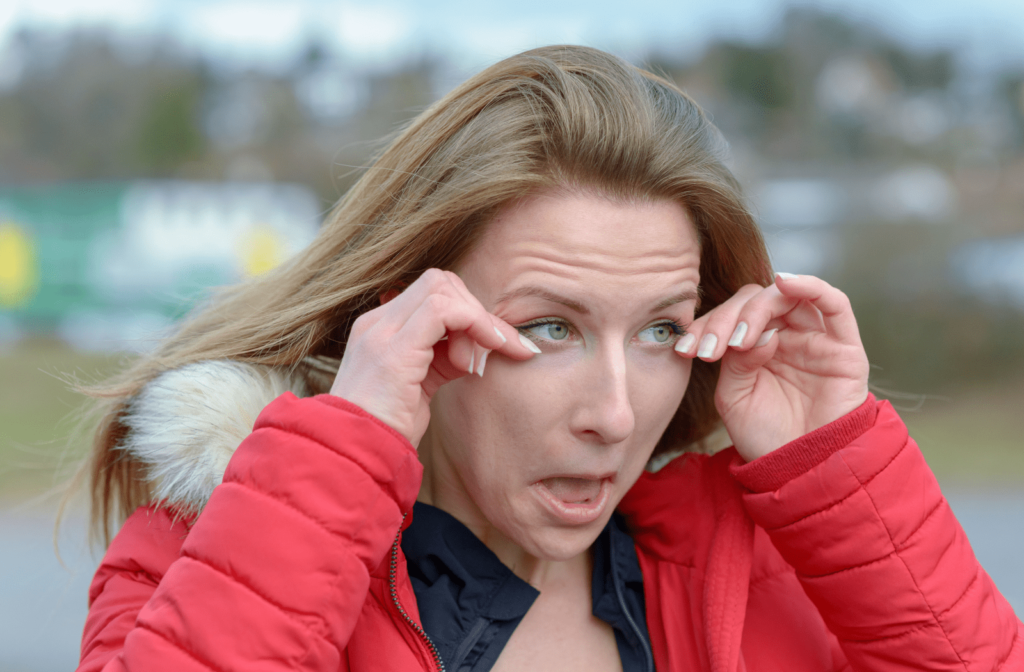The cold weather months bring snow, sleet, and dry air. Winter walking, skating, and other outdoor activities often come with watery eyes that make your eyes red, makeup smudge, and make you look sad when you’re not.
An eye exam can ease your eye health concerns, but watering eyes are typical in cold weather. As counterintuitive as it sounds, your eyes water when they’re too dry. Dry eyes lead to your tear glands producing extra lubrication. The winter months bring the perfect storm of factors to make your eyes water.
What Causes Your Eyes to Water in Cold Weather?
Watery eyes are commonly caused by windy days and cold, dry air that dehydrates your eyes. As your eyes become overly dry, your tear glands will work overtime to produce excess tears. Instead of just lubricating your eyes, tears can fall when your tear ducts are overwhelmed. Even though you’re not sad, your tear glands might make it look like you are. Like a furnace, they cannot turn off right away.
Outdoor conditions aren’t the only reason your eyes water in cold weather. Chilly conditions tempt you to blast the heat in your car or home furnace, producing the dry air it takes to irritate your eyes. This irritation can manifest in spontaneous watering eyes and trigger your tear glands to overproduce lubrication.
As annoying as it can be, watery eyes can sometimes indicate your eyes are healthy. It’s a sign that your tear glands are working as they should and creating the excess lubrication your eyes need as moisture evaporates in cold air.
In other cases, watery eyes can be caused by dry eye disease. When you’re suffering from dry eye disease, watery eyes mixed with other symptoms such as redness, eye fatigue, scratchiness, or pain. Too many tears can indicate issues with your tear film, requiring artificial tears or medicated eye drops to ease the symptoms.

How to Prevent Watery Eyes in Cold Weather?
Running for tissues to combat watering eyes can leave them red and irritated. Preventing watering eyes before they create real tears is the key to overcoming cold weather waterworks.
Wear Glasses
Wearing your glasses and sunglasses in the winter is a simple method to create a barrier between your eyes and the wind. It keeps the humidity between your eyes and lenses contained, so your eyes don’t become overly dry. Contact lenses can also dry out your eyes, so swapping them for your glasses on cold days tends to be beneficial for your eye health. You can also wear sunglasses over your contacts lenses.
Just like with snowboarding and skiing, all winter sports, like snowshoeing and winter hiking benefit from eye protection goggles to prevent eye-watering, irritation and U.V damage.
Add Moisture
It may seem odd to add moisture to eyes that are already watering, but because dry eyes are the cause, eye drops can stop your eyes from producing excess water. Before you go out into the windy, snowy cold, a few drops can keep the surface of your eyes lubricated.
You can also add humidifiers to your indoor spaces to keep moisture in the air. It will counteract the drying effects of your furnace on cold days and promote natural lubrication of your eyes.
Tips to Take Care of Your Eyes in the Winter
In the winter, your eyes need special care. Some tips to keep your eyes extra safe in winter include:
- Keep your eyes safe from snow-related damage and scratches. Shards of icy snowflakes can scratch the cornea.
- Despite the festive season, don’t share mascara or eyeliner with anyone. The risk of spreading bacteria is not worth flawless makeup.
- Don’t be afraid to blink excessively. Your eyes are trying to find the right balance of moisture, and blinking is the best way to lubricate your eyes.
Should You See an Optometrist for Watery Eyes?
If you notice your eyes water in cold weather with no other irritation or symptoms, your eyes are likely trying to prevent your eyes from getting overly dry.
If you’re noticing that your eyes are persistently watering, regardless of the environmental conditions, you may be experiencing epiphora––which is the scientific term for tearing or watery eyes.
Epiphora
When the tear film can’t drain properly, or there is an overproduction of tears, you can experience watering eyes. There’s a balance between healthy tears that keep the eye’s surface healthy and too much tearing that negatively affects your vision.
People who develop consistent watering eyes may notice other symptoms, including:
- Redness in the eyes
- Swelling
- Blurred vision
- Eye fatigue
- Mucus around or in the eyes
- Difficulty wearing contact lenses
In cold, windy weather, these symptoms can intensify.
These indicators of watering eyes can be uncomfortable, and you may notice difficulty when driving at night and more sensitivity to screens or other lights. These markers are a sign that you need to see an optometrist.
Dry Eye Disease
When your eyes are overwatering, it’s a common sign of dry eye disease. Your eyes are trying to lubricate themselves by flooding with tears. It indicates a problem with your tear film where your tear layers are out of balance. Your tear film can be affected by:
- Too much exposure to screens
- Poorly fitted contact lenses
- Eyelid inflammation
- Certain prescription medication
- Ocular surgery
- Meibomian gland dysfunction (MGD)
Dry eye disease is common, but you don’t have to live with it. Detail your symptoms to your optometrist to start treating dry eye disease and stop your eyes from overwatering.
Still Experiencing Watering Eyes?
If you’re concerned about watering eyes in cold weather or any other season, York Mills Eye Care can thoroughly examine your eyes and tear ducts to get to the root of your concerns. Book an appointment with our team to discuss your eye health and learn how to keep your eyes at their best in cold weather.




